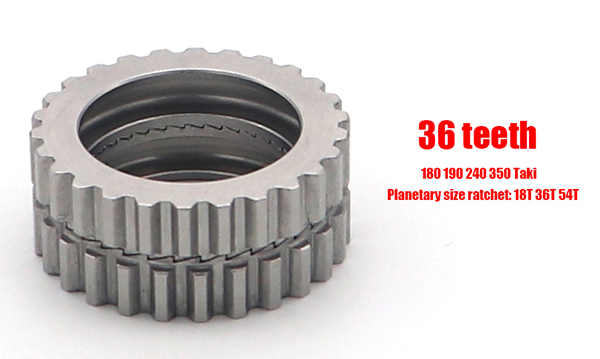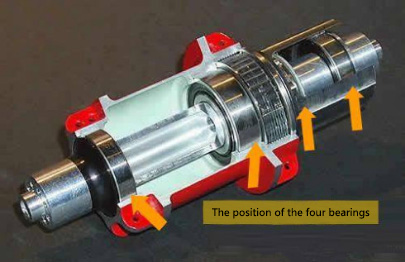
The quick release is a kind of fastener which is specific to bikes. The handle of the quick release is just the secret of the quick release. The shaft of the handle penetrates the hole on the head of the quick release level. The shaft can swing relative to the quick release level. There forms a cam at the end of the handle, working in coordination along with the handle seat.
The cam will push the handle seat if you move the handle from an open position to a closed position—then the distance between the handle seat and the nut which is at another end of the quick release level will be reduced and the quick release will be tighten. In addition, there is another kind of quick release whose cam is wrapped in the quick release clamp so you can’t see it.
The operational principle of this kind of quick release is totally the same as what we introduced above.
The quick release used for the axle has two little springs. These two little springs can make the two ends and the head of the axle have basically equal distance after the quick release is open, which will make you easier to install the wheels on the frame—two spaces are corresponding to two axle hooks so the axle can be put into the opening of the hook directly and the quick release will not be a hindrance. The quick release on the seat post clamp don’t need these two springs.

The history of the quick release
The quick release, invented by an Italian named Tullio Campagnolo in 1930, is an ingenious component which is very suitable for bikes.
He took part in an amateur bike racing in the winter of 1927. At that time each side of the rear wheel of the bike had one freewheel and these two freewheels differed in size.
Using the big freewheel would save effort when you cycled uphill. And you could be faster if using the small freewheel to cycle downhill or on the flat ground. If you wanted to change the freewheel, you had to take off the rear wheel, turn it over and install it on the bike again. At that time we used the wing screw to install the axle and we could tighten it by hands directly.
But the snow froze the screw in winter and Campagnolo’ hands were frozen so he couldn’t tighten the screw. Then he began to think hard about some methods to improve it. Three years later, he invented the popular quick release. In 1933, he invented the derailleur once more which lays the groundwork for the modern bikes with derailleur. From then on, a famous bike component brand called Campagnolo appears. The quick release also exists in their trademark as Campagnolo’s fist invention—the handle of the quick release and the flying wings.
The instructions of the quick release
The quick release plays a role in fastening key components of the bike–wheels and the seat post. If you can’t use the quick release rightly, you can’t make sure that the wheels and the seat post have been well tightened, which will cause a serious accident. So we must tighten the quick release rightly and conform to some precautions to ensure it can be used safely.

The first thing I need to note is that don’t ever regard the handle of the quick release as the cranking bar and use it to rotate the quick release level when you are tightening the quick release! This kind of operation is totally wrong by which you can’t get enough fastening force—little power will be produced when the quick release level is rotated into the quick release nut.
The main reason is that the handle of the quick release is too short to produce the torsion. (Think about the wretch which is used to tighten the axle nut. Its moment arm of force is at least a dozen centimeters in length.) In addition, the size of the nut and screw is too small to have good ability to tighten. Unfortunately, every one has the common sense to use the nut and the screw to tighten components. There have nuts and screws on the quick release and also has a small handle on the screw.
Those who don’t know the quick release well will naturally think of “shaking”, which makes this seriously wrong operation mode happen easily. So we want to emphasize here that make sure don’t do it like that!

We should also note that the wrong operation mode of “shaking” will damage the quick release, the frame and the front fork as well. The chances are that the excessive spinning force will cause serious damage to the screw thread of the nut and the screw because the reason why the screw thread is designed here is to bear the load and it is not endowed with the ability to withstand the abrasion and occlusion when being rotated by strong power. Friction among the quick release clamp, the bike frame and the front fork will form scratches.
In fact, the quick release has its own tightening structure—namely the cam, which has been mentioned above. When tightening the quick release, you should adjust its tightness first. The adjustment method is as follows: rotate the nut of the quick release, and tighten it slowly at the time of pulling the handle of the quick release to test its tightness, making the handle of the quick release begin to experience resistance when the handle of the quick release and the quick release are in a line—it means that if you want to continue to close the handle of the quick release, you should exert more strength from this angle. This kind of adjustment method aims to exert the strength easily. After finishing adjustment, you can move the handle of the quick release hard to get it tightened. You should move it through at least 90 degrees. At the same time, you can feel that you have exerted so much strength (You have to use the palms to move it) and feel the “resilience” which is produced when the quick release are lengthened (In fact, the quick release obtains the fastening force by lengthening the quick release slightly. As long as the quick release has good lubrication you can feel this kind of force. ). If you feel the force is weak when tightening, there maybe have two reasons: one reason is that the cam of the quick release shows signs of serious wear, which can not lengthen the quick release efficiently,so you should change to a new one immediately; another reason lies in the size of the frame.
When the axle is put into the axle fork, there are spaces between the axle fork and the head of the axle. You fail to make the quick release level tight enough because of these spaces when you are tightening the quick release, so you should make it tighter when adjusting the tightness. When tightening the quick release, you’d better move it more frequently. You move the handle of the quick release through over 90 degrees just after the handle of the quick release and the quick release level are almost in the line. If you can feel that the resistance of the handle of the quick release has been reduced, it means it just passes through the highest point of the cam and now the quick release is in stable condition. It will not loosen easily and be very reliable.
In order to prevent the handle of the quick release from loosening accidentally because of the strange stuff, the direction of the quick release really matters. Generally,the quick release of the front wheel faces backwards or runs parallel to the front fork while the quick release of the rear wheel faces backwards or runs parallel to the seat stay. The quick release of the seat post clamp usually faces downwards or forward or runs parallel to the stem of the frame. Some handles of the quick releases of the seat post clamps look like semi-rings, which can be moved forward horizontally and be put into the seat post clamp.
If you want to open the quick release, what you should do is to loosen the handle until it is vertical to the quick release level. At this point, both the quick release seat and the quick release nut will separate themselves from the axle fork, the wheel can be taken off, and the seat post clamp be loosened. The openings of some axle forks have two projections while there is a loop of bulging edge around some axe forks. All these projections can prevent the wheel from falling out of the axle fork when the quick release loosens accidentally so it belongs to a safety design.
With this projection, pulling the handle of the quick release until it is open is far from being enough when you need to install and take off the wheel. Only the quick release nut is loosened, you can install and take off the wheel smoothly. In fact, these projections are not necessary and a lot of frames and front forks haven’t this kind of design. As long as the quick release is installed properly, it is also all right and it can be installed and taken off easily. You don’t need to screw the quick release nut every time. If you want to check whether the quick release is installed properly, you can lift the bike up and make the wheel suspend from the sky, then punch the wheels downwards. If the wheels are not loose, it means the quick release has been installed properly. The reliable way, however, is to readjust the tightness of the quick release and tighten it properly.

The maintenance of the quick release
The main maintenance of the quick release is its lubrication. Adding enough lubricating grease on the cam of the quick release can reduce the wear of the cam. And adding a thin layer of lubricating grease on the screw thread of the quick release can prevent rust, corrosion and thread occlusion. Some quick release clamps whose surfaces produce friction with the cams are made of engineering plastic. This kind of quick releases don’t need to lubricate the friction surface between the cam and the quick release clamp, but you’d better lubricate the axle of the cam.
Precautions
1.You must check the quick release for fear that other people have used it and you can’t fasten the wheels and the seat post reliably after parking your bike in public places because the quick release can be operated without any tool and attract people’s attention easily.
2.For bikes with brake discs, you can’t put the handle of the quick release on the side which has a disc brake for fear of touching the disc.

























 .
.


